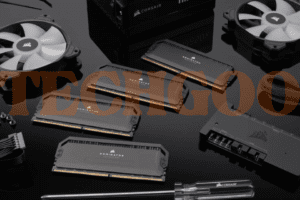To choose a laptop power bank, you need one with at least 18,000mAh capacity and the right ports to connect to your specific laptop. Laptops require more electricity than phones, so regular power banks may not be powerful enough.
It’s important to consider the capacity and compatibility with your laptop when selecting a power bank. When it comes to choosing a laptop power bank, there are a few key factors you need to consider. Laptops require more electricity than phones, so finding a power bank that can meet your laptop’s charging needs is crucial.
In this guide, we will discuss the important factors to keep in mind when choosing a laptop power bank, such as capacity and compatibility with your specific laptop model. By considering these factors, you can ensure that you select the right power bank to keep your laptop charged and ready to go wherever you are.

Understanding Laptop Power Banks
Choosing a laptop power bank requires considering factors such as power output, battery capacity, and ports. Look for a power bank with at least 18,000mAh capacity and the right ports to connect to your specific laptop.
What Is A Laptop Power Bank?
A laptop power bank is a portable device that can charge your laptop when you’re on the go. It acts as an external power source that you can carry with you to ensure that your laptop never runs out of battery.
Laptop power banks come in various sizes and capacities, allowing you to choose one that suits your needs.
How Does A Laptop Power Bank Work?
Laptop power banks work by storing electrical energy from an external power source, such as a wall outlet or USB charger. This energy is then transferred to your laptop through the power bank’s output ports. The power bank acts as a bridge between your laptop and the external power source, providing a continuous power supply even when you don’t have access to electricity.
Benefits Of Using A Laptop Power Bank:
- Convenience: With a laptop power bank, you can work or use your laptop anywhere without worrying about finding a power outlet. This makes it perfect for business travelers, students, or anyone who is frequently on the move.
- Extended battery life: Laptop power banks can significantly extend your laptop’s battery life. This is especially helpful when you’re working on important tasks and don’t have access to a power source for an extended period.
- Portable and lightweight: Laptop power banks are designed to be portable and lightweight, making them easy to carry in your bag or backpack. They are a convenient solution for those who need to use their laptop while on the go, such as during flights or outdoor work sessions.
- Multiple charging options: Laptop power banks usually come with multiple output ports, allowing you to charge not only your laptop but also other devices like smartphones, tablets, or other USB-powered devices simultaneously.
- Fast charging: Many laptop power banks offer fast charging capabilities, which can charge your laptop quickly and efficiently. This is especially useful when you have a limited amount of time to charge your laptop before your next meeting or trip.
- Compatibility: Laptop power banks are designed to be compatible with a wide range of laptop brands and models. Whether you have a MacBook, Dell, HP, or any other laptop, you can find a power bank that suits your specific requirements.
By understanding what a laptop power bank is, how it works, and the benefits it offers, you can make an informed decision when choosing the right power bank for your laptop.
Factors To Consider When Choosing A Laptop Power Bank
When choosing a laptop power bank, there are several factors to consider. First, determine the power output and battery capacity needed to charge your specific laptop. Additionally, check for the right ports and ensure the power bank has a sufficient capacity, typically around 18,000mAh or more.
When it comes to choosing a laptop power bank, there are several factors to consider in order to make the right decision. Here are the key factors you should keep in mind:
- Laptop compatibility: Before purchasing a power bank, ensure that it is compatible with your laptop model. Check the power requirements of your laptop and compare them to the power bank’s output specifications. It’s important to choose a power bank that can provide enough power to charge your laptop efficiently.
- Battery capacity and output power: The battery capacity is an essential factor to consider when selecting a power bank. The higher the capacity, the longer your laptop can run on battery power. Look for a power bank with a capacity that matches or exceeds your laptop’s battery capacity. Additionally, consider the output power of the power bank. Make sure it provides sufficient power to charge your laptop at the desired rate.
- Number and type of ports: Assess your charging needs and choose a power bank that offers the right number and type of ports. Consider the devices you will be charging in addition to your laptop, such as smartphones or tablets. Look for a power bank with multiple USB ports or other compatible ports to conveniently charge multiple devices simultaneously.
- Size and weight: Portability is crucial when it comes to power banks. Consider your usage scenarios and prioritize a power bank that is compact and lightweight, making it easy to carry around. A bulky and heavy power bank may not be practical, especially if you frequently travel or work on the go.
- Brand reputation and customer reviews: To ensure reliability and quality, consider the brand reputation of the power bank manufacturer. Look for reputable brands known for producing high-quality power banks. Additionally, read customer reviews to gain insights into the experiences of other users. Their feedback can provide valuable information about the power bank’s durability, performance, and overall customer satisfaction.
By considering these factors, you can choose a laptop power bank that meets your specific needs and ensures that your laptop remains powered up wherever you go. Remember to prioritize compatibility, battery capacity, port availability, size, weight, and brand reputation when making your decision.
Step-By-Step Guide To Choosing The Right Laptop Power Bank
Looking for a step-by-step guide on how to choose the right laptop power bank? You’ll find all the information you need, from power output to battery capacity and ports, in this comprehensive guide. Say goodbye to low battery anxiety and make sure you have the perfect power bank for your laptop.
When it comes to choosing a laptop power bank, there are several factors to consider. To help you make an informed decision, follow this step-by-step guide:
Checking the laptop’s power input specifications:
- Determine the power input requirements of your laptop, usually indicated on the power adapter or in the user manual.
- Confirm the voltage (V) and amperage (A) requirements to ensure compatibility with the power bank.
Calculating the power needed for your specific usage:
- Assess your typical laptop usage, including tasks like web browsing, video editing, or gaming.
- Estimate the number of hours you use your laptop on the go to determine the power capacity required.
How often do you need to charge your laptop on the go?
- Evaluate how frequently you need to charge your laptop away from a power source.
- Consider this usage frequency while selecting the power bank’s capacity.
Do You Need To Charge Multiple Devices Simultaneously?
- Determine if you need to charge other devices such as smartphones or tablets along with your laptop.
- Look for power banks with multiple ports and the ability to charge different devices simultaneously.
Understanding mAh and Wh ratings:
- Become familiar with milliampere-hour (mAh) and watt-hour (Wh) ratings, which represent the capacity of the power bank.
- Higher mAh or Wh ratings indicate more power storage and longer charging capabilities.
Choosing the appropriate capacity for your laptop:
- Decide on the capacity of the power bank based on your laptop power consumption and charging frequency.
- Higher-capacity power banks provide more charges but may be bulkier.
Ensuring the power bank supports your laptop model and brand:
- Check if the power bank is compatible with your laptop model and brand.
- Look for power banks that specify compatibility with various laptop brands and models.
Compatibility with USB-C, USB-A, and other charging standards:
- Check the power bank’s compatibility with your laptop’s charging connector, such as USB-C or USB-A.
- Verify if the power bank supports the charging standards required for your laptop.
USB-C, USB-A, and other ports for charging different devices:
- Look for power banks that provide both USB-C and USB-A ports to charge different devices.
- Determine the number and types of ports you need based on your device charging requirements.
Quick charge and PD (Power Delivery) support:
- Consider choosing a power bank with quick charge or Power Delivery support for faster charging times.
- This feature is particularly useful if you need to charge your laptop quickly in a limited time.
Portable and lightweight options for travel convenience:
- Assess the portability of the power bank to ensure ease of carrying while traveling.
- Look for lightweight and compact power banks that fit easily in your bag or pocket.
Balancing capacity and portability according to your needs:
- Strike a balance between power bank capacity and portability based on your usage patterns.
- Consider your priorities to choose a power bank that best suits your needs.
Checking for reliable and reputable brands:
- Research and select power banks from reliable and reputable brands.
- Trusted brands often provide quality products with reliable performance and long-term durability.
Reading user reviews and ratings for performance and reliability:
- Read user reviews and ratings to gauge the performance and reliability of different power bank options.
- Consider feedback from other users to make an informed decision.
Determining how much you are willing to spend on a laptop power bank:
- Set a budget or price range for your laptop power bank purchase.
- Determine how much you are willing to invest in a quality power bank.
Finding a balance between features and cost:
- Evaluate the features and specifications offered by different power bank options.
- Find a balance between the features you require and the price you are willing to pay.
Comparing different laptop power banks based on your requirements:
- Compare different power banks based on their specifications, capacity, features, and price.
- Create a shortlist of power banks that meet your requirements for further evaluation.
Considering the overall value and customer satisfaction:
- Look for power banks that offer good value for money based on their features, reliability, and performance.
- Consider customer reviews and satisfaction ratings to gauge the overall value of the power bank.
Remember, choosing the right laptop power bank is crucial for uninterrupted productivity on the go. Use this step-by-step guide to make an informed decision and find the perfect power bank for your needs.
Frequently Asked Questions Of How Do I Choose A Laptop Power Bank?
What Size Power Bank Do I Need For My Laptop?
For laptops, you’ll need a power bank with at least 18,000mAh capacity and the right ports for charging.
How Do I Know If My Power Bank Is Compatible With My Laptop?
To determine if your power bank is compatible with your laptop, check its capacity (at least 18,000mAh) and make sure it has the correct ports for your laptop.
Should I Get 10000Mah Or 20000Mah Power Bank?
A 10000mAh power bank is suitable for charging phones, while a 20000mAh power bank is better for charging laptops.
Can A 20000Mah Power Bank Power A Laptop?
Yes, a 20000mAh power bank can power a laptop with the right ports and at least 18000mAh capacity.
Conclusion
When it comes to choosing a laptop power bank, there are a few key factors to consider. First and foremost, you’ll want to make sure that the power bank has the right capacity to meet your laptop’s needs. Laptops require more electricity to charge compared to phones, so it’s recommended to opt for a power bank with at least 18,000mAh capacity.
Additionally, it’s essential to ensure that the power bank has the necessary ports to connect to your specific laptop. Different laptops may require different types of ports, so double-checking compatibility is crucial. Another important consideration is the power output of the power bank.
The higher the power output, the faster your laptop will charge. Lastly, it’s a good idea to read reviews and ratings from other users to get an idea of the power bank’s reliability and durability. By keeping these factors in mind, you’ll be able to choose a laptop power bank that suits your needs and helps keep your device charged on the go.




